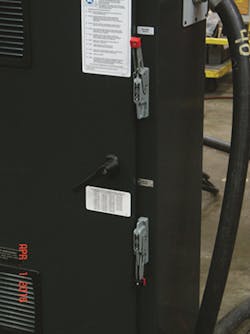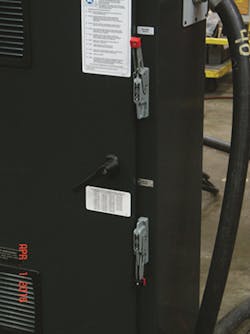Special Report: Technology expands approach for accident prevention
There's plenty of activity afoot, both from regulatory agencies and machinery suppliers, when it comes to ensuring that plastics manufacturing facilities are safe.
The good news is that more sophisticated technology is allowing manufacturing plants to maximize safety for their employees. Smarter controls, especially, are enabling a more nuanced approach to safe machine operation. The key takeaway, according to one control supplier, is that safety and productivity are not necessarily at odds.
These technology advancements are having an impact on industry standards development. Current work on that front includes work on lockout/tagout procedures, as well as reporting requirements for workplace injuries.
MACHINERY BUILDER POINTS TO IMPROVEMENTS
OEMs have made great strides in improving the safety of all types of plastics processing equipment, said Bruce Catoen, chief technology officer of Milacron Holdings Corp., Cincinnati. "The machinery that the industry is producing has never been as safe to operate as it is today," he said. In his view, every injury and every lost-time accident is preventable, and a lot of that is tied to the safety program in the manufacturing plant, as well as machinery compliance with current safety standards.
Asked about particular strides, Larry Keller, chief engineer at Milacron's Batavia, Ohio, facility, noted that guarding has improved to prevent access to dangerous areas of the press. Also, redundancy has been built in to monitor machine components when they fail. "Controls play a big part of that," he said. He also noted that communication protocols are improved as well, allowing more reliable communication between the machine and robots or other devices in a manufacturing cell.
In addition, Catoen said the move from hydraulic to electric clamp operation has also resulted in safer operation. "When you have electrics, it's on-demand movement, so you can control it and monitor its condition a lot easier than you could with pneumatics or hydraulics," he said.
Keller agrees. He says that reliability of controls has improved greatly over the last 10 years. On top of that, safety modules have enabled cross-checking among safety devices on a machine, especially in the last five years
Both Catoen and Keller said that one of the ongoing challenges facing manufacturers is the growing number of standards that need to be met. Catoen said the plastics industry is seeing a proliferation of safety standards, at both the national and state level. "For machinery builders, it is becoming increasingly complex to abide by all of the global standards," he said. He added that this makes it a challenge for plastics processors, making it difficult to transfer a machine from one area to another with different safety standards.
Keller noted that the industry is moving toward more universal safety standards. "Currently, with the ISO standards, we are trying to develop an international injection molding standard," he said, adding that progress has been slow.
CONTROLS SUPPLIERS TEAM UPWITH OEMS ON SAFETY
Sophisticated sensors are better able to detect the presence of machine operators, and in some cases, machines such as robots are able to modify movement to avoid causing injuries. Technology advancements are also making possible alternatives to lockout/tagout procedures in certain manufacturing scenarios, allowing for quicker start-up after maintenance tasks are performed. Controls suppliers said they work closely with OEMs to incorporate safety features into plastics processing machinery and ancillary equipment such as robots.
Mathias Radziwill, who is responsible for business development, plastics OEMs, at Siemens Industry Inc., Norcross, Ga., said the company has sought to streamline automation architecture by integrating processing and safety features into its Simatic controllers, which also simplifies wiring and programming costs. He noted that the logic of the safety functions is software-based, which offers more flexibility than hard-wired functions, and is more easily expanded, modified and documented.
Radziwill said Siemens provides technical support to OEMs "from the beginning of the planning phase," including training and help with documentation tools to be in compliance with ISO standards. He said the collaboration includes risk assessment and evaluation of safety functions, as well as guidance on protective measures for risk reduction.
George Schuster is business development manager for Rockwell Automation Inc., Milwaukee. He pointed to efforts in three areas that are aimed at improved safety: harmonization of industry standards from various standards organizations to ease compliance; end-to-end safety technologies, including PLCs, networks and advanced functions on motor controllers; and "design philosophies" that are allowing OEMs to address systemic failures in safety more effectively.
Among the advancements that are improving safety, Schuster pointed to passive designs that do not require action on the part of the operator. For example, a light screen will detect someone reaching into the machine, and will automatically put the machine into a safe, disabled state. He also pointed to configurable designs that allow the operator to selectively enable or disable portions of the machine, for example, to perform cleaning without completely powering down the machine.
In Schuster's view, the long-standing thinking that safety and productivity are inherently at odds is changing. "Industry data proves that you can improve safety, reduce injuries and improve system yield by designing a system that better complements the tasks that people need to perform on equipment," he said. "That's a game changer."
He observed that technology advancements have allowed operators and machinery to interact in a more intimate way, and those interactions are enabled by safety technologies, controllers and robust fault-tolerance systems that enable a system to operate properly in the event of failure of some of its components.
As an example, he pointed to lockout/tagout procedures for the control of hazardous energy sources during maintenance. While lockout/tagout has served the industry well for years as a way to control hazardous energy sources, he said the time-consuming process of powering down a molding press has become cumbersome and a hindrance to productivity, as manufacturing lines have become increasingly complex. This has been an incentive for molders to bypass the lockout/tagout process, creating an unsafe condition.
Yet smarter controls have allowed certain maintenance tasks to be performed without powering down the press entirely. Increasingly, he said, OEMs and processors are turning to specifications such as ANSI Z244.1, which covers lockout/tagout and alternative methods, which he said should complement, rather than replace, lockout/tagout procedures. "It gives us a specification basis to use advanced safety systems as an alternative for lockout/tagout for the control of hazardous energy under specific scenarios," he said.
Schuster compares safety to a chain: it's only as effective as its weakest link, and there are many links to implement a safety function. For example, being able to open a gate and disable a machine involves sensing that the gate is opening and coordinating its motion with all of the hazards in the manufacturing cell. Communicating all safety-related data throughout a manufacturing line is essential, he said.
DEVELOPMENTS ON THEREGULATORY FRONT
In the regulatory arena, there are a several initiatives that are important to plastics processing plants and OEMs, said Marie Gargas, senior technical director, environment, health and safety, at SPI.
On the federal level, OSHA is finalizing a rule to Improve Tracking of Workplace Injuries and Illnesses, which was proposed in November 2013. The rule would require facilities to electronically transmit to OSHA information that is currently recorded but not necessarily reported to the public on a periodic basis, such as details about specific workplace injuries and illnesses, including the company and location.
SPI has asked that OSHA withdraw the proposal, maintaining that OSHA's objectives could be better met through increased resource allocation towards collaborative initiatives and compliance assistance.
At the state level, David Palmer, SPI's director of industry affairs—Equipment Council, said two regulations affect the way operators conduct mold die changes on injection molding machines in Michigan. One of the regulations, the Michigan Occupational Safety and Health Administration (MIOSHA) General Industry Safety Standard Part 62, Plastic Molding, pertains to die changes on horizontal injection molding machines. The other standard, Part 85, The Control of Hazardous Energy Sources, pertains specifically to the use of lockout/tagout procedures to prevent the unexpected or unintended movement of the platens due to startup or release of stored energy. Palmer said that SPI is working with MIOSHA to ensure that the standard is in line with the federal OSHA standard.
In other work, the SPI is revising the ANSI/SPI B151 safety standards for both horizontal and vertical injection molding machines. According to Palmer, based on the results of a risk assessment conducted in 2014, the standard will make the jam bar optional on horizontal machines but required on vertical presses due to the possibility of platen closure by gravity during a control system failure. The revised standard, which will cover both horizontal and vertical presses, will be consistent with both European Union and ISO standards for the same types of machines.
Beyond rulemaking, Gargas expects to see higher penalties from OSHA. She noted that OSHA has implemented a new weighted enforcement system that could result in an increase of citations. In addition, Department of Justice and Department of Labor initiatives will aid criminal prosecutions of worker safety violations. Also, inspectors from OSHA and the Environmental Protection Agency will be cross-trained to spot potential violations in the other agency's jurisdiction.
On top of that, OSHA civil monetary penalties will increase this year, potentially by as much as 80 percent. Gargas noted that OSHA civil monetary penalty limits have not increased since 1990. The Congressional Bipartisan Budget Act of 2015 removed a long-standing provision that has kept the agency from increasing its penalties to adjust for inflation.
She said OSHA will increase the fines by Aug. 1. Plants that have been issued a citation will be subject to a higher penalty if the claim is settled after that date, she said.
John DeGaspari, senior correspondent
Contact:
Milacron Holdings Corp., 513-536-2000, www.milacron.com
Rockwell Automation Inc., 414-382-2000, www.rockwellautomation.com
Siemens Industry Inc., 800-743-6367, www.usa.siemens.com
SPI, 202-974-5200, www.plasticsindustry.org


